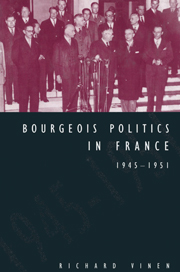Book contents
- Frontmatter
- Contents
- Preface
- List of abbreviations and French political groups
- 1 Introduction
- 2 A historiographic overview
- 3 International comparisons
- 4 Notables
- 5 Bourgeois parties and the female electorate
- 6 Organized business and politics
- 7 Administration
- 8 Opposition nationale
- 9 The Parti Républicain de la Liberté
- 10 Machine à ramasser les Pétainistes? The Mouvement Républicain Populaire and the conservative electorate
- 11 The Rassemblement des Gauches Républicaines
- 12 The Rassemblement du Peuple Français
- 13 Independents and Peasants
- 14 The Groupement de Défense des Contribuables
- 15 Conclusion
- Appendix. The electoral law of 1951 and apparentements
- Bibliography
- Index
3 - International comparisons
Published online by Cambridge University Press: 06 July 2010
- Frontmatter
- Contents
- Preface
- List of abbreviations and French political groups
- 1 Introduction
- 2 A historiographic overview
- 3 International comparisons
- 4 Notables
- 5 Bourgeois parties and the female electorate
- 6 Organized business and politics
- 7 Administration
- 8 Opposition nationale
- 9 The Parti Républicain de la Liberté
- 10 Machine à ramasser les Pétainistes? The Mouvement Républicain Populaire and the conservative electorate
- 11 The Rassemblement des Gauches Républicaines
- 12 The Rassemblement du Peuple Français
- 13 Independents and Peasants
- 14 The Groupement de Défense des Contribuables
- 15 Conclusion
- Appendix. The electoral law of 1951 and apparentements
- Bibliography
- Index
Summary
The history of the Fourth Republic is often compared with what went before and came after in France. However, this period can equally well be compared with what happened simultaneously in other European countries. Such a comparison throws up many similarities. Almost all the countries of Europe were involved in physical and economic reconstruction after the war. Almost all countries were also involved in social reconstruction to rebuild the order that been shaken by the war. In all countries, there was an expectation of social reform: the occupation of France and Belgium, and the fascist regimes of Italy and Germany, seemed to have discredited part of the ruling class. This expectation was disappointed and a variety of conservative forces triumphed in general elections of 1948 (Italy), 1949 (Belgium and Austria) and 1951 (France and the United Kingdom). Furthermore, all European countries were affected by the Cold War, and by the increasing influence of the United States. This triumph of bourgeois Europe was also marked at an international level by the North Atlantic Treaty of 1949 that brought together most west European nations under American aegis. This chapter will attempt a brief general survey to show how France fitted in with, and diverged from, a general European model.
The most obvious common denominator linking France with Germany, Belgium and Italy after the war was the fact that all four countries had endured a period of authoritarian government.
- Type
- Chapter
- Information
- Bourgeois Politics in France, 1945–1951 , pp. 21 - 30Publisher: Cambridge University PressPrint publication year: 1995

